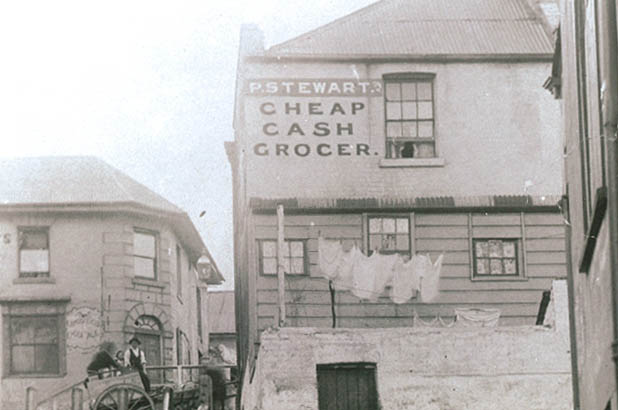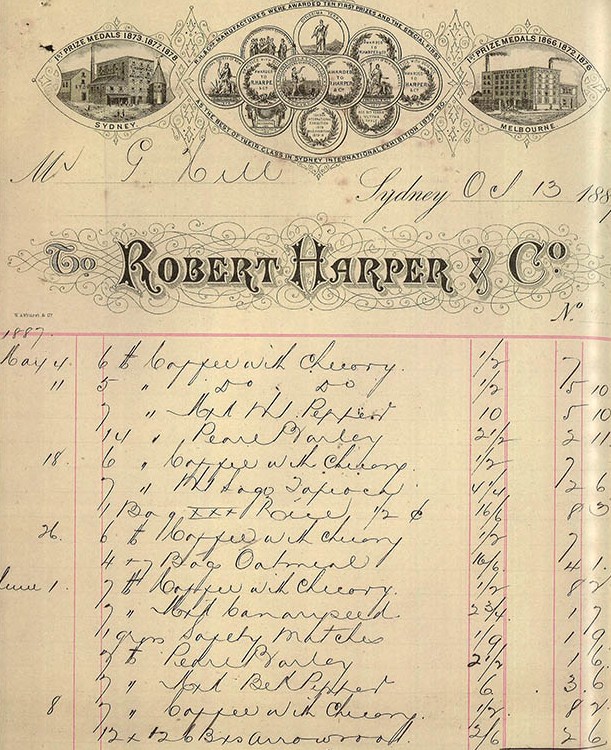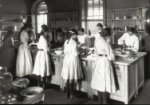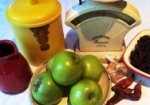The ‘cash grocer’ on the corner of Susannah Place at 64 Gloucester Street was serving local customers for over 90 years. During this time there were 12 shopkeepers who lived onsite with their families. The two we know most about are George Hill, who ran the shop from 1879 – 1890, and the Youngeins, who ran the shop from 1904 to 1930.

Rear of the Susannah Place terrace, Cumberland Place, The Rocks (detail). Mitchell Library, State Library of NSW
‘No cash’ grocer
Luckily for us (not so much for him) after running the shop for eight years, George Hill found himself in considerable debt. He went bankrupt in 1887, leaving behind a trail of official documents.
His application for voluntary sequestration (bankruptcy) includes invoices listing ‘goods sold and delivered’. Debtors included local suppliers and their invoices give us a good idea of the type of items that were in demand.

Goods supplied by Robert Harper and Co to grocer George Hill. Excerpt from George Hill’s bankruptcy file, 1887. Supreme Court, Insolvency Files, State Records NSW
On the shelves
Some items such as oatmeal and rice, pearl barley, split-peas and black pepper are as you’d expect today but others, such as tapioca or ‘coffee & chicory’ have all but lost their place in our pantries. Sardines and kippered herrings jostled for space on the shelves with arrowroot biscuits and household essentials such as safety matches and canary seed, alum and carbolic soap. Chocolate crèmes, fancy (iced) biscuits and the mysteriously named ‘G. Cakes’ would satisfy those who hadn’t time to make their own sweet treats. Interestingly, lime juice, nutmeg and curry powder were supplied by wholesale ‘Druggists and Drysalters’ Elliot Brothers. Colonial brands like Starkey’s lemonade, Monk Vinegar, J. C. Smith eggs, Heinrich & Raith bakers, Cameron flour mills, John Shearman cheese, and Riley golden syrup have been lost to history.
Strangely, despite being forced to sell his stock and furniture to repay his debts, George continued to run the shop for another 11 years.
Childhood memories
Skip forward to the 1900s and we have Clara and Hugo Youngein running the ‘cash grocer’. It is the Youngein shop that has been recreated as part of the museum today, based on the memories of one of their sons. In 1990, aged 89, Jim Young still vividly recalled details of shop fittings such as the counter, scales and gaslight as well as shop stock, suppliers, the people of the neighbourhood and life at Susannah Place. Given the size of the Susannah Place shop, it must have been like an Aladdin’s cave – crammed full of household necessaries, dominating the lives of the Youngein family.
The Youngein shop sold all manner of food – butter, sugar, tea, eggs, milk, bread, flour, cheese, pickles, honey, sultanas and currants, tinned salmon, sardines and herrings. Salted salmon was kept in brine in casks and dried, filleted pieces of ling were sold to Scandinavian and other European families living in the area.
Fish is a recurring theme in Susannah Places histories – either caught fresh from the harbour or purchased from local shops (- recall Fred Hughes’ memories of fish stews on the stove). Fish was popular during Lent and Easter and probably made a regular appearance on tables each Friday in many households. Jams such as Lackersteen’s were sold in tins while vinegar, sauces, and drinks were sold in bottles with glass marble stoppers. Brightly coloured boiled lollies were displayed in glass jars in the window which ex-resident Les Gallagher fondly remembered from his childhood.
Paper and string
Goods received in bulk were weighed out and packaged in smaller quantities. Tea, sugar, flour, currants and sultanas were sold in paper bags tied with string. Eggs were individually wrapped in newspaper before being put into a bag and Jim recalled the art of folding the bags to seal them before the days of sticky tape. Jim also helped his father to blend teas;
My father … used to use a saucer as a gauge and he’d put one saucer of broken Orange Pekoe to perhaps 2 saucers of broken tea and then he’d weigh them on the scales.
The shop also sold essential household items such as millet brooms, feather dusters, floor polish, wooden pegs and soaps. For lighting, there were candles, kerosene for lamps and gaslight mantles. Other goods ranged from tobacco to chamber pots.
End of an era
Hugo Youngein died in 1930 and the shop was taken over by Eliza and Robert Snedden. It must have been challenging, running a small grocery business during the hard years of the Depression. The business was put up for sale in 1934 but there were no takers and the shop closed down for good by 1935.

Hugo Youngein poses outside his ‘Cash Grocer’, No 64 Gloucester Street, c1920s (detail). Courtesy Young family

